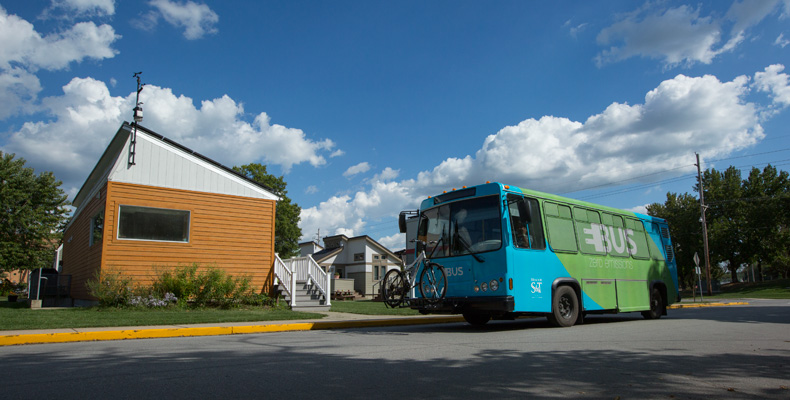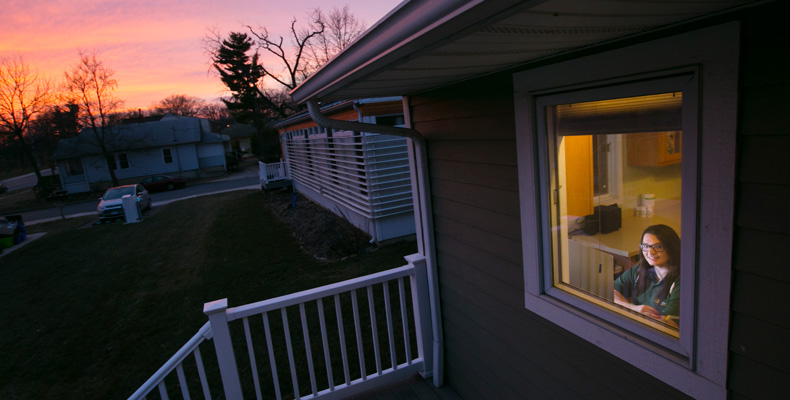
The university’s eBus and Solar Village are just two of the ways S&T is researching and implementing smarter and more sustainable ways of living as part of its Smart Living signature area. Sam O’Keefe/Missouri S&T
Missouri S&T’s Smart Living signature area concentrates on improving your quality of life. Its researchers work to transform home, workplace, transportation and energy infrastructures into “smart” environments.
Smart Living also helps expand the world’s understanding of how people and technology interact. It’s more than just creating sustainable homes. It means developing intelligent systems that will change the future of everyday life.
“Currently, there is a rapid expansion of technology that impacts our lives each day,” says Nathan Weidner, assistant professor of psychological science at S&T. “Weak artificial intelligence systems – algorithms that help us make choices throughout the day – lead us to make better decisions and are having a clear impact on society. These technologies can be so small that they are wearable but have an enormous influence on us.”
Smart Living draws on S&T’s strengths in cyber security, sustainable energy research, social dynamics, usability, big data analytics, architectural design, behavioral and environmental psychology, and transportation and infrastructure to lead research and development efforts toward a more secure and sustainable society.
“People in these new smart systems will have to learn to share resources,” says Bruce McMillin, professor of computer science and associate dean of the College of Engineering and Computing. “With that comes the need for privacy and security. This allocation of resources carries a lot of personal information in it, and we must rely on history to give us clues to help predict the future of this technological advance.”
“Trust in human-computer interaction and AI decisions is important, but there are immediate problems that need to be considered as well,” says Weidner. “For example, if a metropolis has a large number of electric car drivers, what will happen when they arrive home for the night and all plug in their vehicles at 10 p.m.? We don’t want rolling blackouts to happen to that city nightly, so energy storage needs to be considered.”
Research in Smart Living includes:
- Smart grid and transportation systems. Intelligent peer-to-peer systems manage renewable energy resources like wind and solar, which are backed by energy storage, including fuel cells and batteries, to provide energy to buildings. S&T’s Solar Village is a “micro” example of a smart grid in operation. Transportation and energy systems interlink with improved urban planning to provide individualized, cost-efficient transportation.
- Decision-making and governance. Smart living requires more than data and analytics. Understanding how people process, react to and interact with information and technology will lead to a sustainable shared governance of resources.
- Privacy and security. Intelligent systems must be resistant to security attacks while maintaining personal privacy and supporting the users’ trust in the system. In Smart Living, people must adapt to the technology and the technology must adapt to the people. The result is enhanced trust and security.
- Building materials. New smart materials turn buildings into “living laboratories” that, through advanced analytics, provide feedback to inform users as well as to adapt to human behavior. This leads to improved infrastructure, chemical or biological environments, and decision-making. Embedded sensors can monitor how efficiently a building uses energy, water or even bandwidth, empowering people to make informed decisions on how to use resources wisely.
“Usually, we think of technology as leading the charge in this area, but if we do that we risk missing the human aspects of living,” says Nancy Stone, professor of psychological science at S&T. “The human aspects have a very high potential for research, with acceptance and ethics both needing to be addressed to ensure the needs of individuals are being met.”
S&T’s Smart Living initiative is led by McMillin and Stone. Smart Living is an interdisciplinary effort pursued jointly by faculty from arts, languages, and philosophy; business and information technology; chemical and biochemical engineering; civil, architectural and environmental engineering; computer science; economics; electrical and computer engineering; engineering management and systems engineering; English and technical communication; history and political science; mathematics and statistics; mechanical and aerospace engineering; and psychological science. It also involves industry partners and other University of Missouri System campuses to make the research a statewide effort.
Story by Peter Ehrhard
Video by Terry Barner


Recent Comments